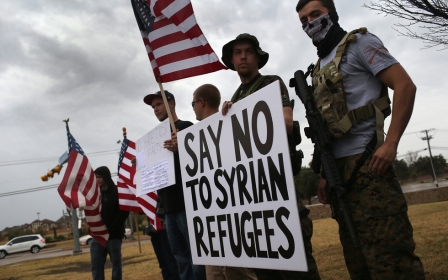Trump to set US refugee quota at 45,000

The Trump administration plans to cap the number of refugees admitted to the United States in the coming year at 45,000, two people with knowledge of the decision said on Tuesday, and advocates said this historically low level is insufficient in the face of growing humanitarian crises worldwide.
That figure would be the lowest ceiling for refugee admissions since the US Refugee Act was signed in 1980. Since then, the ceiling has never been set below 67,000 and in recent years has hovered around 70,000 to 80,000.
The secretaries of State and Homeland Security are consulting with members of Congress on Wednesday, according to one White House official. The president's decision on the refugee limit will be announced following that consultation, two officials said. The Wall Street Journal first reported the 45,000 figure on Tuesday.
By law, the president is required to consult with members of Congress about the number of refugee admissions before the start of each fiscal year, on 1 October.
The number of refugees actually admitted to the country, which can fall below the cap, dropped to its lowest in the fiscal year after the September 11, 2001 attacks with only around 27,000 admitted.
For fiscal year 2017, which ends 30 September, former President Barack Obama established a cap of 110,000 refugees for permanent resettlement in the United States.
After taking office in January, President Donald Trump issued an executive order lowering the maximum number to 50,000 for 2017, saying that more would be "detrimental to the interests of the United States".
Critics said if the 2018 level is set even lower, it could damage the international reputation of the United States.
"It's tragic," said Robert Carey, former director of the Office of Refugee Resettlement under Obama. "It's really moving away from the commitments the government has had for protections of refugees from both Republican and Democratic administrations," he said. "Some people will die."
In a speech to the United Nations last week, Trump said that more could be done to help refugees in their home regions. Offering financial assistance to hosting countries "is the safe, responsible, and humanitarian approach," Trump said.
But that type of assistance "ignores all the people who have fled to places that are still not safe," said another former Obama administration official, Anne Richard.
"Those are the people that the US programme really rescues," said Richard, a former assistant secretary for refugees and migration at the State Department.
She said other countries might try to follow suit by closing the door to more refugees.
A September 2016 study by the libertarian think tank the Cato Institute found that of 3.3 million refugees admitted to the United States between 1975 through 2015, only 20 were convicted of planning or committing a attack on US soil.
A spokesman for the Department of Homeland Security declined to comment ahead of Trump's final decision on the cap. The State Department did not immediately respond to a request for comment.
David Inserra from the conservative think tank The Heritage Foundation said Congress should have more of a say in setting the cap to avoid radical swings in the numbers when there is a change in administrations.
New MEE newsletter: Jerusalem Dispatch
Sign up to get the latest insights and analysis on Israel-Palestine, alongside Turkey Unpacked and other MEE newsletters
Middle East Eye delivers independent and unrivalled coverage and analysis of the Middle East, North Africa and beyond. To learn more about republishing this content and the associated fees, please fill out this form. More about MEE can be found here.




